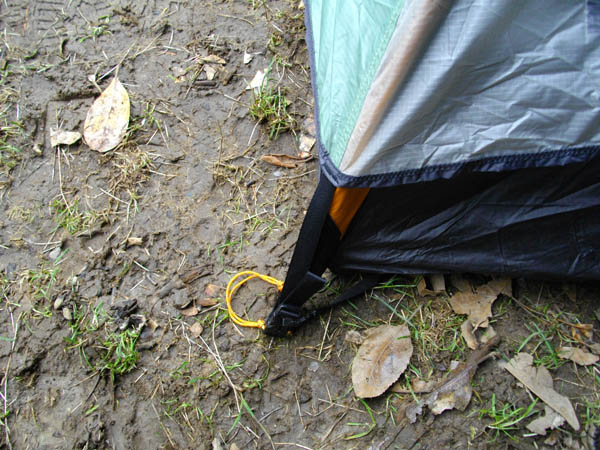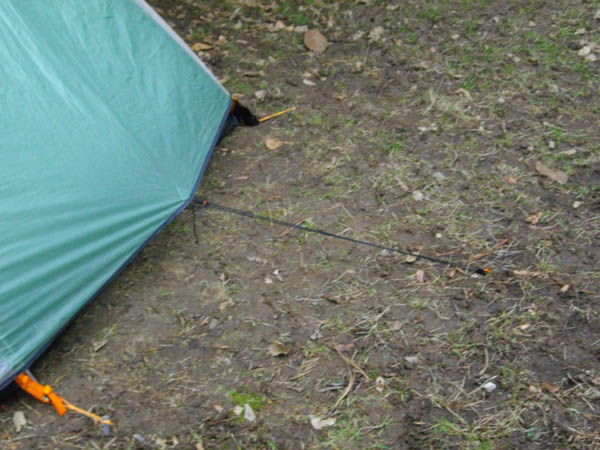Earlier, Ploss and I salvaged what remained of what was to be a truly awesome spectacle: one week on the trail. One work fail and one quadriceps fail later, Ploss was most fortunately able to work a solo expedition to Olympic National Forest, followed by this hike – the 33 mile Wahtum Lake – Herman Creek Loop – to complete an 80+ mile week. Not bad 🙂
WAHTUM LAKE – HERMAN CREEK LOOP VIA PCT, HERMAN CREEK TRAIL
DISTANCE: 32.2 MILES (AS DESCRIBED) | SCENERY: 7 | DIFFICULTY: 6

Local area of Columbia River Scenic Area/Mark O. Hatfield Wilderness
- Trailhead: Wahtum Lake Campground
- Camp 1: Benson Camp
- Camp 2: Casey Creek Camp
Day One: Wahtum Lake to Benson Camp. September 17, 2009. 11.3 miles (with side trips to Chinidere Mtn. and Ruckel Creek)
The day began with an interesting Google Maps FAIL, providing us with an opportunity to explore some of the greater Hood River area private forest lands, do a little offroading, and spend some QT with Giant Tractor Guy in the middle of freaking nowhere. Ultimately we acquired good directions at a local Gas n’ Sip and made our way to the Wahtum Lake Campground parking lot. From here, Trail 406B, the “Anthill Trail” (a) makes its way around the east si-eed of Wahtum Lake, gaining about 700′ along a periodically exposed, narrow trail, crossing Trail 409, terminating at Trail 406. You’ll be back here, later. From here you can take a right for a side trip up Tomlike Mountain (h) (which the author has yet to actually find visit), otherwise head left on Trail 406 for 0.8 miles to the junction of Trail 2000 – the Pacific Crest Trail. Note: this section is typically totally dry until you reach Benson Camp. Carry enough water to cover Day 1.

Above Wahtum Lake from Anthill Trail
This section includes a remarkable area of old growth trees stretching as far as the eye can see, and snow can linger in this shaded area well into summer. McLovin’s photos of this area are inferior to Ploss’ and I will ping dude to get some shots worthy of this amazing dense forest grove.
Not far from here you’ll see a sign indicating a side trail up and to the right leading to Chinidere Mountain (b) – a 1.25 mile (total) side trip which should not be missed, especially on a clear day! [side note: a few hundred feet short of the Chinidere trail, to your left, is a shortcut spur to Wahtum Lake; if ascending from Eagle Creek you can bypass the entire area east of Wahtum Lake via this trail). At 4673′ Chinidere Mountain provides spectacular 360° views of Wahtum Lake, the Columbia River gorge, Mount Hood, Mount Adams, Mount Rainier, Mount St. Helens, and the entire surrounding Scenic Area and National Forest. Best place for lunch McLovin has ever been!

Mount Hood as seen from Chinidere Mountain summit

Ploss getting his lunch on. Be alert for a healthy, aggressive local yellowjacket population
Head back down, take a right and continue on the PCT through a meandering 4+ miles that alternate between thick forest and open vistas until you reach Camp Smokey – a worthy camp if it’s vacant, and if it’s late. Water can sometimes be found a half mile down from Camp Smokey, but you should not count on it. From here you’ll journey through more old growth as you reach the plateau summit, and will find many small meadows scattered throughout the breezy, open forest cap. Just a bit further lay Benson Camp which has a decent adjacent water source, as well as reliable Ruckel Creek a mere mile further.

Benson Camp, ~4000'
Benson Camp isn’t particularly scenic, but there are two very large campsites on either side of the small creek that separates it (essentially the headwaters of Ruckel Creek). On two occasions this creek provided ample water; most recently, not so much. Journey forward about .70 miles to Ruckel Creek proper for reliable water. At night you’ll hear both owls and trains from opposite distant directions, as the Columbia River Gorge lay relatively close down Ruckel Ridge below. [Note: take some time to explore the various spurs (c) surrounding Benson Camp – trails 405, 405a, 405b and 405c – for excellent summit views and silent, magnificent old growth]. Sleep system: BPL Pro 90 Quilt; Therm-a-Rest NeoAir pad; Ptarmigan Bivy; SMD Gatewood Cape. Can’t endorse any highly enough but if you’re forced to pick only one, get the Gatewood Cape. Twice.
Day Two: Benson Camp to Casey Creek Camp. September 18, 2009. 12.4 miles (with side trip to Herman Creek @ Casey Creek Camp)
We left the familiar comfort of Benson Camp and headed towards the junction of Ruckel Creek trail, near Hunter’s Camp – another possible and often occupied camp at the summit of Ruckel Creek Trail and a good spot for water. H2O is really of NO concern today, especially after you reach the Herman Creek Trail itself, but the next 6 miles after the Hunter’s Camp junction will be mostly dry, so fill up! Continue on Trail 405B until you rejoin Trail 2000 (Pacific Crest Trail) and head left/down/NE towards the Columbia River. This section is a long, steep descent – from 4000′ to about 500′ – over about 6.5 miles, and you’ll have epic views of the Columbia River Gorge below at several intervals along the way (d). Enjoy!

Switchbacks begin, with views of Mt. Adams (Mt. Hood off camera) and Herman Creek tributaries (also off camera. As are other things!...)
Down below, you’ll have various views of the many smaller creeks that feed Herman Creek that you’ll pass over the next day, cutting through the landscape. Stop periodically for twenty and look up – the view behind is money too!

Crowns overhead from the way you've come
Eventually you’ll reach the bottom and find yourself at the Herman Creek Trail junction – less than a half mile from the Herman Creek bridge and an excellent water source. Fill up as you want, there’s plenty of water en route to Casey Creek. More on that later.

Herman Creek Bridge

If you see Indian Point...you've taken the Nick Eaton trail. D'oh!
There’s only about 3 miles to go from here, and it’s a slow, gradual climb that includes some truly magnificent waterfalls. Fill up to your heart’s desire – you’ll thank me later!

These 100' falls will provide you with endless photo bounty
This section levels off when the forest gets dense, and ultimately you’ll find the spacious, not particularly scenic Casey Creek Camp. Casey? Casey Creek? Where did you go? Yeah…Casey Creek itself is essentially dry and the nearest good source on Trail 406, Hazel Creek, is exactly 1 mile away. D’oh! If you didn’t fill up enough along the way, you’ll want to head .70 miles down trail 407 (e) (from the rear of the camp itself) to East Fork Herman Creek. Straight down. Think coal mine shaft, with a death-defying rappel at the bottom. It beats the 2 mile round trip to Hazel Creek, maybe? but just barely. Try to plan ahead! Sleep beneath Casey Creek camp’s giant widowmakers and enjoy the peaceful sounds of rushing water below.
Day Three: Casey Creek Camp to Wahtum Lake. September 19, 2009. 8.5 miles
Several more falls await you as you begin this last day on Herman Creek trail. Plenty of water early on. Stock up as you like until you reach Whiskey Creek (f) which represents the last reliable water of the day. This section starts out very mellow, with a gradual climb through a few waterfalls, twists and turns above the East Fork of Herman Creek, immersed in lush forest.

Now entering rainforest
It’s a short 3.5 mile hop from Casey Creek to aptly named Cedar Swamp Camp – you’d prefer not to camp here. Not only is this whole section incredibly damp, with abundant signs that it’s predominantly so year-round, but signs of a recent, significant local fire abound. In other words, keep moving. You’ve climbed about 1300′ at this point, and this camp really marks the end of a generally mellow section. Not far past Cedar Swamp is a last good source of water for the last 4 miles of the day.
From here you begin your ascent back up to Wahtum Lake, which begins gradually through a thick, bushwacking few miles of overgrown brush (g). Unfortunately for us, we reached this point right when it started to rain. Pour. The wet overgrowth served as a car wash-like soaker, and given our relative proximity to Wahtum (and the car) we pushed through w/o stopping to put on rain gear. This was as wet as McLovin has ever been on trail, but we made excellent time motoring up to the 4000′ “summit” near the Mud Lake spur. Here the trail grade lessens slightly, and for the next mile we mostly just wondered if we were in fact summiting Tomlike Mountain. We were not. This was however where we discovered that McLovin’s fabled Road To Nowhere (circa 2008) was in fact within a whisker of the Tomlike Mountain trail (h) – just not littered w/pink and orange ribbons and impossible to pass. Impassible.
Soon you’ll reach the familiar junction of the Herman Creek Trail 406 and Trail 406B – the Anthill Trail. Make your 700′ gradual ascent and equivalent descent to the Wahtum Lake Campground parking lot over the next 2.2 miles and call it a day. We were totally soaked, fairly beat, and willing to help a group who misjudged the distance from the Eagle Creek trailhead to Wahtum by providing a ride for one back to Hood River to meet his wife and get their group a lift out. All in all this was a scenic, moderate 3 day loop that I’ll definitely want to rock again.




























